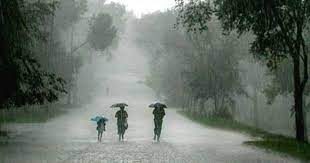Amid the climate catastrophe, the Northeast states experience a rain shortfall and a temperature increase
Northeast India’s living circumstances are altering as a result of decreased rainfall during the south-west monsoon and rising temperatures, notably in the conflict-torn state of Manipur, which has seen a severe rainfall deficit of 48% since June 1.
According to yearly data from the India Meteorological Department, rainfall in northeast India between June and September has significantly decreased recently, after a period of excessive monsoon rain until the mid- to late 1990s and a period of average rainfall until the early 2000s.
The effect is particularly noticeable in Manipur, where there has been an almost 50% fall from the long-term average between 1961 and 2010; in Nagaland, there has been a reduction of up to 20%.
Long-term trends are documented in the meteorological bureau’s state-by-state yearly climate report for 2022, which indicates a 0.5 degree Celsius warming over the base period of 1981 to 2010. The northeastern states have developed into a climatic hotspot due to their distinctive biodiversity and coexistence of several tribal ethnic tribes.
The northeastern states of north Manipur, Nagaland, Arunachal Pradesh, and east Assam are among those with a diminishing tendency in rainfall, according to our examination of long-term rainfall patterns from the 1950s forward. The recent depressions and feeble inland reach of the monsoon may be to blame for this, according to climate scientist Roxy Mathew Koll of the Indian Institute of Tropical Meteorology in Pune. According to our study, a major factor in the diminishing monsoon flow across the greater Indian subcontinent is the ocean’s increasing warming. It’s plausible that the same holds true for the northeastern states, but we need a thorough examination of the area.
Manipur’s paddy-growing valley areas and the supply to the hill regions are being impacted by declining rainfall.
In many areas, paddy is no longer economically feasible. Agriculture in Manipur is rain-fed. According to T. Brajakumar Singh, Deputy Director, Directorate of Environment, Manipur, the hill areas have already switched to horticulture, while the valley regions are now switching to pisciculture. “We have suggested switching to some crops that are climate resilient.”
“High erosion during extreme rainfall and very low soil fertility have a particularly negative impact on slope agriculture,” Singh added. In the last five to six years, individuals have been adversely impacted by rainfall reduction. Conflict and dread are also present this year.
In order to address concerns about food security, planting patterns must alter, he said.”In Manipur, there is a severe 48% rain deficit this season. Tamenglong has a 50% deficit, Churachandpur an 86% one, Chandel an 82%. Evidently, this has had a serious effect on agriculture and food,” Singh added.
According to Indubhushan, president of the Bharatiya Kisan Sangh in Manipur, rainfall has been decreasing in that state over the last ten years. According to a tweet from the Raj Bahawan on August 9, representatives of the farmers’ organization visited Manipur Governor Anusuiya Uikey and asked for the provision of seeds for other crops, claiming that paddy farming in the state had decreased by 30% owing to insufficient rainfall.
“Farmers near hill regions are also often caught in the crossfire (of the ethnic conflict),” added Singh. That has an effect on agriculture as well. Due to little rainfall and interethnic conflict, sowing has been delayed significantly, he noted.
Nemthianngai Guite, an associate professor in the School of Social Sciences at Jawaharlal Nehru University, said that there is a significant knowledge gap in comprehending and recording how climate change is affecting people’s lives in the northeast. According to Guite, “Climate change has definitely increased the region’s vulnerability, including Manipur, which is dealing with ethnic strife and conflict.” The availability of nutrient-dense traditional foods from the highlands is also being impacted by climate change.
“It’s critical to record the availability of groundwater. Assam, Mizoram, and Arunachal Pradesh are already listed as being very susceptible in the Department of Science and Technology’s climate vulnerability study, but Manipur is also extremely vulnerable, she said.
Meghalaya is also seeing a similar trend of decreasing rainfall, although this has not yet had an influence on the production of rice. “Our yearly average rainfall is around 1,200 mm. Although rainfall is decreasing, there is still enough for one paddy crop. However, there has been a change in how I have felt the temperature increase during the previous 30 years of my employment, according to K N Kumar, chairman of the Meghalaya Farmers'(Empowerment) Commission. Buildings did not previously have fans, but now virtually all have them—and in some instances, air conditioners as well.
Since June 1, there has been a 6% rain shortage throughout the nation, with shortages of 25% or more in Nagaland, Manipur, Mizoram, and Tripura, 28% in Gangetic West Bengal, 35% in Jharkhand, 30% in Bihar, and 45% in Kerala, among other states.
According to the Met department, the average temperature has risen 0.62 degrees across Nagaland in the last century. In the last 100 years, the maximum temperature has increased by 0.83 degrees. Similar tendencies may be seen in Manipur, where the annual mean temperature is rising by 0.68 degrees per century and the maximum temperature is rising by 0.91 degrees per century.







